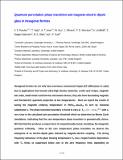Files in this item
Quantum percolation phase transition and magneto-electric dipole glass in hexagonal ferrites
Item metadata
| dc.contributor.author | Rowley, S. E. | |
| dc.contributor.author | Vojta, T. | |
| dc.contributor.author | Jones, A. | |
| dc.contributor.author | Guo, W. | |
| dc.contributor.author | Oliveira, J. | |
| dc.contributor.author | Morrison, F. D. | |
| dc.contributor.author | Lindfield, N. | |
| dc.contributor.author | Baggio-Saitovitch, E. | |
| dc.contributor.author | Watts, B. E. | |
| dc.contributor.author | Scott, J. F. | |
| dc.date.accessioned | 2017-07-26T13:30:06Z | |
| dc.date.available | 2017-07-26T13:30:06Z | |
| dc.date.issued | 2017-07-17 | |
| dc.identifier | 250197988 | |
| dc.identifier | 3211fa1f-7a4d-4773-830e-946781d09126 | |
| dc.identifier | 85026372625 | |
| dc.identifier | 000405697700001 | |
| dc.identifier.citation | Rowley , S E , Vojta , T , Jones , A , Guo , W , Oliveira , J , Morrison , F D , Lindfield , N , Baggio-Saitovitch , E , Watts , B E & Scott , J F 2017 , ' Quantum percolation phase transition and magneto-electric dipole glass in hexagonal ferrites ' , Physical Review. B, Condensed matter and materials physics , vol. 96 , no. 2 , 020407(R) . https://doi.org/10.1103/PhysRevB.96.020407 | en |
| dc.identifier.issn | 1098-0121 | |
| dc.identifier.other | ORCID: /0000-0002-2813-3142/work/48131877 | |
| dc.identifier.uri | https://hdl.handle.net/10023/11292 | |
| dc.description | SER and EBS acknowledge support from a CONFAP Newton grant. T.V. acknowledges support from the NSF under Grant No. DMR-1506152. | en |
| dc.description.abstract | Hexagonal ferrites do not only have enormous commercial impact (£2 billion/year in sales) due to applications that include ultra-high density memories, credit card stripes, magnetic bar codes, small motors and low-loss microwave devices, they also have fascinating magnetic and ferroelectric quantum properties at low temperatures. Here we report the results of tuning the magnetic ordering temperature in PbFe12-xGaxO19 to zero by chemical substitution x. The phase transition boundary is found to vary as TN~(1 - x/xc)2/3 with xc very close to the calculated spin percolation threshold which we determine by Monte Carlo simulations, indicating that the zero-temperature phase transition is geometrically driven.We find that this produces a unique form of compositionally-tuned, insulating, ferrimagnetic quantum criticality. Close to the zero temperature phase transition we observe the emergence of an electric-dipole glass induced by magneto-electric coupling. The strong frequency behaviour of the glass freezing temperature Tm has a Vogel-Fulcher dependence with Tm finite, or suppressed below zero in the zero frequency limit, depending on 2 of 18 composition x. These quantum-mechanical properties, along with the multiplicity of low-lying modes near to the zero-temperature phase transition, are likely to greatly extend applications of hexaferrites into the realm of quantum and cryogenic technologies. | |
| dc.format.extent | 6 | |
| dc.format.extent | 1286318 | |
| dc.language.iso | eng | |
| dc.relation.ispartof | Physical Review. B, Condensed matter and materials physics | en |
| dc.subject | QC Physics | en |
| dc.subject | QD Chemistry | en |
| dc.subject | TK Electrical engineering. Electronics Nuclear engineering | en |
| dc.subject | NDAS | en |
| dc.subject.lcc | QC | en |
| dc.subject.lcc | QD | en |
| dc.subject.lcc | TK | en |
| dc.title | Quantum percolation phase transition and magneto-electric dipole glass in hexagonal ferrites | en |
| dc.type | Journal article | en |
| dc.contributor.institution | University of St Andrews. School of Chemistry | en |
| dc.contributor.institution | University of St Andrews. EaSTCHEM | en |
| dc.contributor.institution | University of St Andrews. School of Physics and Astronomy | en |
| dc.contributor.institution | University of St Andrews. Condensed Matter Physics | en |
| dc.identifier.doi | 10.1103/PhysRevB.96.020407 | |
| dc.description.status | Peer reviewed | en |
| dc.date.embargoedUntil | 2017-07-17 |
This item appears in the following Collection(s)
Items in the St Andrews Research Repository are protected by copyright, with all rights reserved, unless otherwise indicated.

